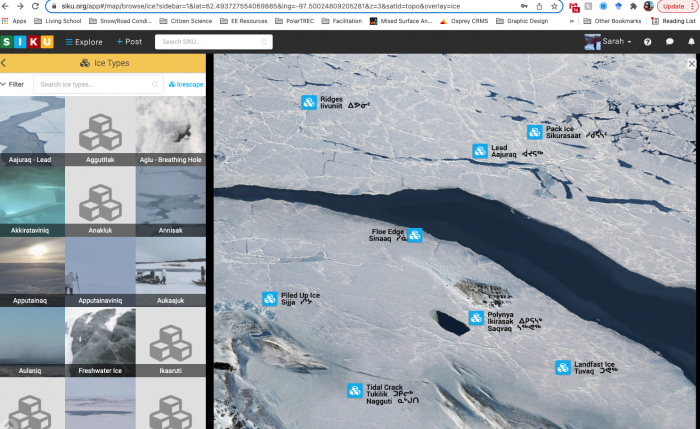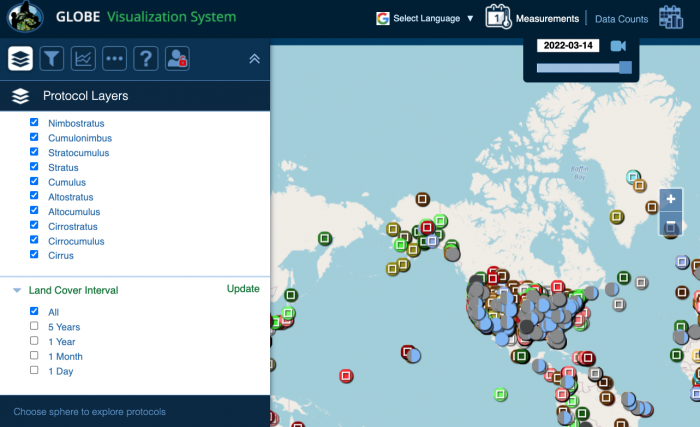Making Observations
The International Arctic BuoyA float moored in water or ice to mark a location, warn of danger, or indicate a navigational channel. Program (IABP) is responsible for accurate highly precise observations of weather conditions of the atmosphere above the Arctic Ocean as well as the temperature of ocean water and movement of sea ice. The observation data is then used by many other science and research teams to interpret the changing Arctic.
People who are not formally trained scientists also take observations of the current conditions of the landscape; actually we all do this everyday to help us decide which clothes to wear if it is a warm, wet, cold, or windy day outside. And some folks go beyond that and have rain gauges outside their homes, thermometers on their windows, and wind socks in their gardens among other weather instruments. The IABP buoys our team is placing out on the sea ice are similar, in that they have instruments inside them that measure the current weather and they have the necessary technology tools to send the data out to a satellite to then beam the data down to a master computer here on Earth.
Community and Citizen Science
Many people around the globe are interested in not only being observers of the places where they are, but also contribute to the collective understanding of how the world works. We call these folks community and citizen scientists.
I was fortunate to participate in an Arctic Research Consortium of the United States (ARCUS) online conference in October 2021: the Community and Citizen Science in the Far North meeting. I learned about so many initiatives happening around the Arctic Circle to not only collect observation data, but to affirm and celebrate the people and culture of who make the observations and share what they are seeing.
In addition to radar, satellite data, and other technologically advanced observation data, the IABP team also relies on citizen science observations from both more formal citizen science projects such as the Alaska Arctic ObservatoryA location used for observing terrestrial and/or celestial events. & Knowledge Hub or AAOKH (most recent observations are on AAOKH facebook page), SIKU, the Indigenous Knowledge Social Network, and Seasonal Ice Zone Observing Network; we also ask and listen to the local people of northern Alaska for their daily sea ice observations and any pertinent knowledge to ensure that we are safe while out finding the best places to deploy the buoys.

Citizen Science Challenge for All Readers
In addition to the deployment of weather buoys, I will also be collecting citizen science data for the NASA GLOBE Observer program and I invite you to do the same from wherever you are on the planet in the next three weeks (and into the future).
All you need is a smartphone and an email address to set up the GLOBE Observer app. Then you can easily learn how to make Cloud and Landcover observations through the app. I have all the instructions clearly explained here. It is important that you join the Wild Rose Education 2022 Arctic (and beyond) observation team so we can see where in the world everyone is making observations.
Let's Have a Contest!
Let's see who can make the most observations with the GLOBE Observer app from now until April 10, 2022. Then whomever has the most observations will win a small prize. You will need to make sure you read the daily journal posts (get them in your email) for instructions on how to let us know how many observations you've made over the next three weeks to be a winner.
Bonus Points
In the 'field notes' section of each observation include any other observations you can make such as temperature (if you have a thermometer), snow depth (need a ruler or yard stick), inches of rain fall (if you have rain gauge), barometric pressure (if you have a barometer), as well as any other observations you can measure.

You will be able to see the observations I make in the Arctic (northern most point of Alaska) on the GLOBE Visualization System map. It does not appear that many GLOBE Observer Clouds or Landcover data have been submitted from the North Slope of Alaska, so my observations will be very useful to the NASA scientists. Also, I will be watching your observations come in through our group team map as well.
Please comment below if you plan to participate and in which region or area of the planet you will be observing. I really look forward to seeing your participation!


Comments